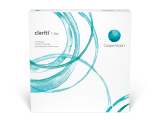by Dr. Melody Huang

Proper contact lens care helps prevent complications such as infection and inflammation. Whether you’re working with a new wearer or a patient who has worn contacts for years, it’s beneficial for all patients to be up to date on contact lens use!
Lens Handling
Here are some handling tips to share with patients1:
- If your eyes are red or irritated, do not wear contact lenses. Use glasses until your eyes clear up, and see your Eye Care Practitioner for an evaluation.
- Do not use contact lenses that are not prescribed for you, and do not share contact lenses with others.
- Check the contact lens packaging to make sure the lenses are not expired. The expiration date is printed on the box and the blister pack.
- Make sure you have the appropriate lens for each eye. Labeling the boxes with “left” and “right” is helpful.
- Always wash your hands with soap (without moisturizing agents) and dry them with a lint-free towel before handling contacts.
- Wait to apply makeup until after lens insertion. Remove the contacts before removing makeup.
- Before inserting any contact lens, check to make sure there are no tears in it. Do not wear a lens if there is a visible tear.
- Avoid letting the contacts dry out. Discard any lenses that dry out and do not attempt to reuse them.
- Remove contacts before swimming, showering, or using a hot tub.
Lens Application and Removal
When training a patient on contact lens application and removal (A&R), demonstrating the steps on yourself or showing them a video of A&R is helpful. Here are the steps to review with patients:
Application1 Steps:
- Wash your hands thoroughly with soap and dry them on a lint-free towel.
- Remove the contact lens from the blister pack or lens case. Start with the right lens if you’re right-handed and the left lens if you’re left-handed. Always start with the same lens to avoid mixing them up.
- Rinse the lens with fresh multipurpose solution or saline solution. Do not use tap water or the solution left in the blister pack or lens case.
- Place the contact lens on your index finger with the edges facing up. Inspect the lens to make sure it’s clean, free of rips, and not inverted. The lens should look like a bowl. If the lens is inverted, the edges flare out.
- Use your non-dominant hand to hold your upper eyelashes. Use the free fingers on your dominant hand to hold your lower eyelashes.
- Focusing on your eye in the mirror, gently place the contact lens directly onto the center of your cornea.
- Once the contact lens is in place, slowly remove your fingers and blink. This helps ensure the lens stays in place and that it’s appropriately centered on your eye.
Removal1,2 Steps:
- Wash your hands thoroughly with soap and dry them on a lint-free towel.
- Remove the contacts in the same order you insert them.
- Looking at your eye in the mirror, check to see that your contact lens is positioned on the central cornea. Then, look up slightly and use your index finger to slide the contact lens down towards the lower eyelid. This makes it easier for you to remove the lens. Use a pinching motion with your thumb and index finger. If your lenses are daily disposable, simply throw the lens away upon removal. Continue with the remaining steps for other lens modalities.
- Place the contact lens in the palm of your hand and apply several drops of fresh multipurpose solution. Gently rub the lens back and forth (not in a circular motion) with your index fingers for about 15 seconds on each side.
- Rinse the lens with fresh multipurpose solution.
- Place the contact lens into the lens case and add enough fresh multipurpose solution to fill the case's entire well. Never top-off old solution with new solution.
- Soak the lenses according to the manufacturer’s instructions on the solution packaging. Most solutions require about four to eight hours of soaking to disinfect the lenses.
- Before reusing the lens case the next day, be sure to rinse it out with fresh solution and let it dry upside down.
- Dispose of your contact lens case every one to three months. A good rule of thumb is to toss your case every time you open a new bottle of solution. Most solutions you can purchase come with a new case.
Watch the CooperVision Application and Removal Video:
Contact Lens Care Systems and Solutions
Contact lens care systems and solutions are designed for cleaning, disinfecting, and soaking the contacts. These care systems remove protein, lipid, and mucin deposits3. They eliminate microbes such as bacteria, viruses, fungi, and amoebae3,4. Manufacturers also include wetting agents and lubricants, which increase contact lens comfort3,5. Additionally, the solutions are pH-balanced to the eye’s natural tears3.
It’s important to advise patients on only using the lens care system prescribed by the Eye Care Practitioner. For example, some private-label (“store brand”) solutions contain older formulations that were not designed for use with silicone hydrogel contacts3.
Multipurpose Solution (MPS)
MPS is an all-in-one lens care system and most commonly used among soft contact lens wearers6. Only one solution is required to clean, rinse, disinfect, and store the lenses6.
Some MPS manufacturers advertise their product as “no-rub.” However, studies have shown that rubbing and rinsing the lenses is the safest way to use contacts, as these steps help remove deposits and microbes2. The American Optometric Association does not recommend any no-rub regimens2.
Some common MPS include:
- Lite™ Multipurpose Solution
- Opti-Free® Puremoist®
- Opti-Free® Replenish®
- Opti-Free® Express®
- Biotrue®
- renu® Advanced Formula Multi-Purpose Solution
- Blink RevitaLens® Multi-Purpose Disinfecting Solution
- Complete® Multi-Purpose Solution Easy Rub® Formula
- All-in-One LightTM
Hydrogen Peroxide-Based Systems
Hydrogen peroxide is a powerful disinfectant3. These systems actively clean and remove debris from the contact lenses. Since there are no preservatives, hydrogen peroxide-based systems are ideal for patients who may have sensitive eyes3. These patients may experience a sensitivity reaction to the chemicals used in MPS3.
Tips for using hydrogen peroxide-based systems:
- The hydrogen peroxide must be neutralized before using the contacts, otherwise, the solution will cause significant burning, stinging, and redness of the eyes6.
- Never place hydrogen peroxide-based solutions directly into the eye6. Most bottles have a red tip to remind patients.
- Some systems have a built-in neutralizer (a small platinum disc built into the case), while others require a neutralizing tablet3. Follow the manufacturer’s instructions on how to neutralize the solution.
- Always use the provided case. Using a different lens case prevents the hydrogen peroxide from neutralizing properly6.
- Dispose of old cases and always use the new case that comes with a bottle of solution. An old case may not neutralize the hydrogen peroxide7.
- After placing the lenses in the holder, rinse them for 5 seconds with fresh hydrogen peroxide solution. Then, fill the case with fresh solution, up to the marked line8. Once the lens holder is placed into the case, the solution will start to bubble.
- Do not shake the case or turn it upside down while disinfecting8. Set it upright in a location where the case won’t get knocked over.
- Allow enough time for the contacts to soak (most systems require at least four to six hours)6. If you remove the lenses too soon, the solution may not be neutralized.
- Upon neutralization, the contacts can be removed from the case and inserted into the eyes. However, some Eye Care Practitioners may advise rinsing the lenses with saline solution before insertion8. Make sure not to rinse with peroxide solution.
Some hydrogen peroxide-based systems include:
- Refine One Step™ Hydrogen Peroxide Solution
- Clear Care®
- Oxysept® Disinfecting Solution/Neutralizer- UltraCare® Formula
Saline Solution
Saline does not disinfect contact lenses and should not be used to soak contact lenses. However, saline can be used for rinsing contact lenses after disinfection with the proper care system6.
Enzymatic Cleaners
Enzymes remove protein deposits from the surface of the lens. Enzymatic cleaners were used as a separate step to remove buildup on conventional lenses typically worn for six months or more3. With frequent lens replacement schedules and MPS with protein-removing abilities, the use of enzymatic cleaners has declined3.
Although some manufacturers have discontinued their soft contact lens enzymatic cleaners, Ultrazyme® Enzymatic Cleaner is available. These tablets are designed for use with hydrogen peroxide-based systems9.
FAQs
These are some frequently asked questions about contact lens use:
Are contact lens solutions effective against the virus that causes COVID-19?
The Centers for Disease Control and Prevention states that hydrogen peroxide-based systems should be effective against this strain of coronavirus6. However, there is not enough evidence to show that multipurpose solutions are effective against the virus6. It’s best to dispose of the contact lens if there is any concern about exposure.
How long can contacts be stored in the lens case?
Every care system is different, and the manufacturer will indicate how long you can store the lens before needing to change the solution. Most MPS allow you to store your lenses for up to one month in a tightly closed case. Hydrogen peroxide-based systems may allow for 24 hours or up to one week of storage. It’s good practice to disinfect the lenses again the night before you plan to use the contacts2.
Can contacts get stuck behind the eye?
No, it is physically impossible for a contact lens to find its way behind your eye. The sclera (white of the eye) is covered with a thin membrane called the conjunctiva. The conjunctiva folds back to line the inner part of the eyelid, making it one continuous membrane. This tissue stops the contact lens from going too far. At most, the lens can get stuck underneath the eyelid10.
Sources
Guidelines for Contact Lens Wear. CooperVision. https://coopervision.com/sites/coopervision.com/files/coopervision_contactlensuserguide_ltr.pdf
Contact Lens Care. American Optometric Association. https://www.aoa.org/healthy-eyes/vision-and-vision-correction/contact-lens-care?sso=y
Gromacki SJ, Ward MA. Understanding Contemporary Contact Lens Care Products. Contact Lens Spectrum. https://www.clspectrum.com/issues/2013/june-2013/understanding-contemporary-contact-lens-care-produ
McMahon TT. Contact Lenses and Pink Eye. Contact Lens Spectrum. https://www.clspectrum.com/issues/2001/may-2001/treatment-plan
Scheuer CA, Doty K, Liranso T, et al. Wetting Agent Retention and Release from Hydrogel and Silicone Hydrogel Contact Lenses. Invest. Ophthalmol. Vis. Sci. 2011;52(14):6487
Contact Lens Care Systems & Solutions. The Centers for Disease Control and Prevention. https://www.cdc.gov/contactlenses/care-systems.html
Contact Lens Solutions With Hydrogen Peroxide: To Avoid Injury, Follow All Instructions. U.S. Food & Drug Administration. https://www.fda.gov/consumers/consumer-updates/contact-lens-solutions-hydrogen-peroxide-avoid-injury-follow-all-instructions?source=govdelivery&utm_medium=email&utm_source=govdelivery
How to Use One Step Peroxide Solution. CooperVision. https://coopervision.com/contact-lenses/aftercare-solutions/refine-one-step/how-to-use
Ultrazyme® Enzymatic Cleaner. Johnson & Johnson Vision. https://www.jnjvisionpro.com/products/ultrazyme®-enzymatic-cleaner
Heiting G. Can a contact lens get lost behind my eye? All About Vision. https://www.allaboutvision.com/contacts/faq/cls-lost-in-eye.htm





